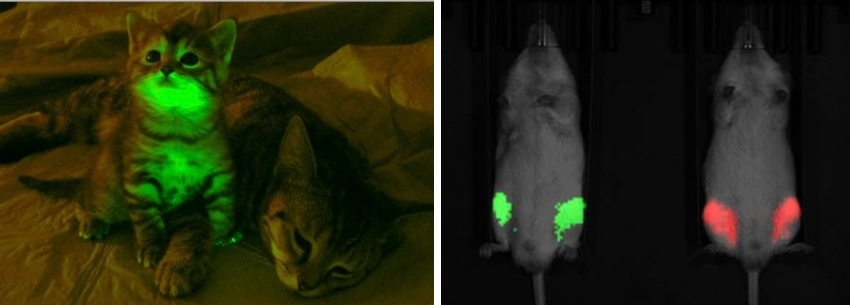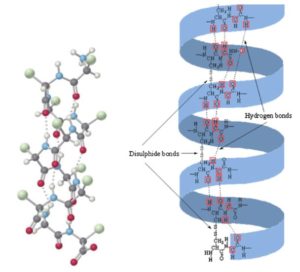At the end of this week’s parasha, Ki Tisa, we read how Moses descended from Mt. Sinai with his face glowing brilliantly (Exodus 34:29-30). The people could not look at his face directly, so he had to wear a mask. The exact wording in the Torah is karan ‘or panav (קָרַ֖ן ע֣וֹר פָּנָ֑יו). The latter two words are clear: “the skin of his face”. But what does karan mean? The most direct translation would be “horn” which is actually why, comically, throughout history some artists depicted Moses with horns! Another way of translating it is as “radiant” (based on this, the Modern Hebrew term for a ray or radiation is k’rinah, קרינה). Rashi comments that both are accurate; karan does indeed come from the word for “horn” because light rays shoot forth like “horns”. If we take a look at Midrash (with a little help from science), we will find that the Torah is secretly encoding something much more profound.
Light of Adam, Light of Moses
The Sages teach that before the consumption of the Forbidden Fruit, Adam and Eve were beings of light. Their skin was radiant and glowing. They lost this light after they ate the Fruit and this is why, when they looked at each other, they were ashamed. Before the Fruit, they saw or (אור), “light”; afterwards, they saw only ‘or (עור), “skin”. (For a detailed explanation of this, see Pardes Rimonim, Gate 13, Ch. 3.) Moses reversed this, and restored Adam’s lost light, as the Midrash (Devarim Rabbah 11:3) records:
Adam said to Moses: “I am greater than you as I was created in the image of the Holy One, blessed be He…” Moses replied: “I surpassed you, since the honour that was given to you has been taken away… as for me, the facial glow that the Holy One, blessed be He, gave me is still with me…”
What Adam lost, Moses regained. Now, what is it, exactly, that Adam lost? What had changed about his skin? Surely, he could not have literally been a being of pure light before the Forbidden Fruit. It’s hard to imagine that Adam and Eve were holograms of photons. They definitely had substance! So, what changed? Another Midrash (Pirkei d’Rabbi Eliezer 14:3) explains that initially, Adam had
a skin of nails (עור צפורן), and a Cloud of Glory covered him. When he ate of the fruit of the Tree, the skin of nails was stripped from him, and the Cloud of Glory departed from him, and he saw himself naked…
The Zohar (II, 208a) says the same, and adds that Adam’s “garment of nails” (לבושי טופרא in Aramaic) was removed, “leaving nothing but the nails at the tips of the fingers”. The Zohar goes on to say that this is why it is customary to look at our nails during Havdalah at the end of Shabbat. On the eve of the first Sabbath, Adam sinned and lost his primordial greatness, plunging the world into darkness. At the end of each Shabbat, we light a flame and look at its light reflected in our fingernails to remind us of the original greatness of Adam, and his nail-like skin.
So, Adam’s original radiant skin was actually a skin of reflective nails. Unlike frail skin, nails are tough and strong. Unlike deceptive skin, which comes in different shades and colours leading to all kinds of conflict between people, nails are uniform and the same among all human beings. Unlike soft and susceptible skin, nails are resistant to sunburns, infections, and the like. Adam’s exterior was originally made of nails; he was truly a superior, powerful being. While this might be hard for us to imagine, it is actually scientifically plausible, for skin and nails are made of the same thing: keratin.
Keratin and Luciferin
The human genome codes for some 54 keratin proteins. We have keratin all over our bodies, primarily in our nails, skin, and hair. The differences between these forms of keratin are in their molecular structure. The main reason nail keratin is hard compared to skin keratin is because it has more sulfur atoms, which link together to form tough disulfide bridges. It is actually not very difficult to do some genetic tweaking and produce the tougher keratin in skin, making it nail-like. In fact, fish scales are also made of keratin, giving fish a tough exterior. So, too, are the horns of most mammals—a shofar is mostly just keratin! And that brings us right back to Moses.
The Torah says that Moses’ face was karan, literally a “horn”. It does not say that his head somehow grew horns, rather, the skin of his face was karan. The soft keratin of the skin had become hard keratin like in horns! This is what made him like Adam, with a radiant nail-like skin. For God, it was a simple switch in Moses’ genome.
While it may be hard to believe that God was a genetic engineer, Judaism has a general principle that God works through derekh hateva, “natural ways”. Perhaps the greatest example of this is the creation of Eve. When God created Eve, the Torah says that He first put Adam to sleep, then took something out of his bone (Genesis 2:21). Why bother mentioning this? Why not just snap Eve into existence? Instead, the description sounds like a modern-day surgical procedure: anesthesia, followed by bone marrow removal. Today, we use bone marrow to derive stem cells, which can then be used for all kinds of things, including culturing new cells and growing organs. Scientifically-speaking, it seems like God made Eve, as might be expected, from Adam’s stem cells! (It has been further pointed out that the rib bone is an ideal place to draw bone marrow/stem cells, since it is right beneath the skin and easy to access.)
So, while we can certainly be traditional and leave Moses’ glowing skin to an inexplicable miracle, we can also go with the derekh hateva principle and find a natural mechanism for it. Better yet, the Torah’s precise language, which once puzzled ancient commentators, totally supports the notion of a keratin (karan) shift in Moses’ skin. That still leaves one issue to discuss: the Torah says that Moses glowed brightly, so much so that people couldn’t look directly at his skin. Nails are reflective, but don’t actually glow. How do we solve this problem?
We find that many hundreds of species exhibit bioluminescence, ie. they glow. The most famous example of this is the firefly. For a firefly, the glow is produced by a compound called luciferin, when it reacts with an enzyme called luciferase. It is definitely possible to insert that gene into human skin to make it glow, too. Such experiments have already been done with mice, and scientists have produced glow-in-the-dark cats using a similar gene called green fluorescent protein. In the case of Moses, if God really did use natural means, He could have inserted the luciferase gene into Moses’ skin as well, resulting in a bright, firefly-like glow.

Glow-in-the-dark cats made with green fluorescent protein, and mice that have been engineered to express luciferin in their cancer cells, lighting up the affected areas.
Today, biotechnology has reached incredible new heights. Gene therapy has been successfully used to transform defective immune cells and cure illness. Recently, we’ve seen a great deal of discussion regarding CRISPR-Cas9 technology which allows even easier gene manipulation. (And the imprisonment, in China, of the scientist behind the first gene-edited babies.) We already consume genetically-modified foods every day. (Did you know that 90% of the world’s cheese, kosher included, is made with recombinant chymosin from genetically-modified microbes?) Meanwhile, scientists have used DNA to store digital information (“downloading” huge terabytes of data into just a few grams of genetic material). What if the Tree of Knowledge produced fruit that literally had knowledge in it? It is certainly within the realm of modern-day science.
And when it comes to indestructible keratin skin, the case of spider silk must be mentioned. Certain types of spider silk are 200 times stronger than steel. Through genetic engineering, scientists have been able to generate larger quantities of these spider silks in the milk of goats. Meanwhile, other scientists have integrated these spider silks directly into human skin to make it bulletproof! The possibilities are endless—and frightening—which is why so many have protested against genetic engineering. It remains to be seen where this technology will lead, and we may soon discover that, perhaps, genetic engineering should best be left to God.
Shabbat Shalom!


